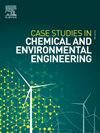越南胡志明市集中工业废水处理厂废水和污泥中的微塑料
Q1 Environmental Science
Case Studies in Chemical and Environmental Engineering
Pub Date : 2025-08-14
DOI:10.1016/j.cscee.2025.101276
引用次数: 0
摘要
微塑料污染日益引起人们的关注,污水处理厂既是屏障,也是污染源。本研究量化了越南胡志明市两个集中式工业污水处理厂的微塑料。微塑料在废水中的浓度为0.3至40.4 μ g−1,在污泥中的干重为29.6至92.0 μ g−1,主要是纤维。尽管去除效率很高,但每天仍排放1.7 × 106个微塑料。讨论了污泥的潜在风险。对全球43个污水处理厂进行的稳健多元回归分析强调,进水浓度是影响污水浓度的最强预测因子,并为与越南2030年减少塑料目标相一致的潜在循证战略提供了见解。本文章由计算机程序翻译,如有差异,请以英文原文为准。
Microplastics in wastewater and sludge from centralized industrial wastewater treatment plants in Ho Chi Minh City, Vietnam
Microplastic pollution is a growing concern, with wastewater treatment plants (WWTPs) acting as both barriers and sources. This study quantified microplastics in two centralized industrial WWTPs in Ho Chi Minh City, Vietnam. Microplastic concentrations ranged from 0.3 to 40.4 items L−1 in wastewater and 29.6–92.0 items g−1 dry weight in sludge, predominantly fibres. Despite high removal efficiencies, 1.7 × 106 microplastics were discharged daily. Potential risks from sludge were also discussed. Robust multivariate regression analysis of 43 WWTPs worldwide underscored the influent concentrations as the strongest predictor influencing effluent concentrations and offering insights into potential evidence-based strategies aligned with Vietnam's 2030 plastic reduction goals.
求助全文
通过发布文献求助,成功后即可免费获取论文全文。
去求助
来源期刊

Case Studies in Chemical and Environmental Engineering
Engineering-Engineering (miscellaneous)
CiteScore
9.20
自引率
0.00%
发文量
103
审稿时长
40 days
 求助内容:
求助内容: 应助结果提醒方式:
应助结果提醒方式:


